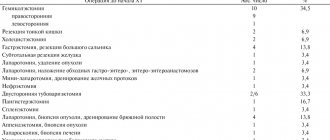Movalis is a non-steroidal anti-inflammatory drug that has a complex effect on all manifestations of inflammation. Gives anti-inflammatory, analgesic and antipyretic effect. The drug relieves unpleasant subjective sensations, and also breaks pathogenetic chains in the development of inflammatory reactions of various origins and localization. The main mechanism of action of meloxicam on inflammatory mediators is inhibition of prostaglandin synthesis.
Pharmacodynamics and pharmacokinetics
Movasin is a nonsteroidal anti-inflammatory drug (NSAID) that exhibits analgesic, anti-inflammatory and antipyretic effectiveness.
The anti-inflammatory effects of Movasin are associated with the ability of meloxicam to inhibit the enzymatic activity of COX-2 , which takes part in the biosynthesis of prostaglandins at the site of inflammation.
Meloxicam also , but to a lesser extent, affects COX-1 , which promotes the synthesis of prostaglandin , which protects the gastrointestinal mucosa and is involved in the regulation of renal blood flow .
For injection, the bioavailability of meloxicam is almost 100%. With intramuscular injection of 5 mg of Movasin, Cmax is observed after approximately 60 minutes and is equal to 1.62 μg/ml.
When taken orally, it is absorbed from the gastrointestinal tract quite well, with a bioavailability of 89%. At oral doses of 7.5 and 15 mg, drug concentrations are dose proportional. After 3-5 days, equilibrium concentrations are observed
The drug has good binding to plasma proteins, especially albumin (99%). It enters the synovial fluid , with a concentration of 50% of the plasma concentration. The volume of distribution is low, averaging about 11 liters. Interindividual differences are approximately 30-40%.
Meloxicam is metabolized almost completely in the liver, releasing 4 inactive metabolites. The main one is 5′-carboxymeloxicam (60%), obtained by oxidation of 5′-hydroxy-methylmeloxicam (an intermediate metabolite), in turn also excreted, but to a lesser extent (9%).
According to in vitro studies, it has been proven that the main role in this metabolic process is played by the CYP2C9 isoenzyme with the CYP3A4 isoenzyme performing an auxiliary function . The release of the other two metabolites (16% and 4%, respectively) involves peroxidase , with probably varying activity.
Excretion occurs in feces and urine equally, mainly in the form of metabolites. 5% is excreted unchanged in feces. On average, T½ is 20 hours, plasma clearance is 8 ml/min.
Meloxicam in doses of 7.5-15 mg has linear pharmacokinetics.
Pathologies of the liver or kidneys of moderate severity do not significantly affect pharmacokinetics.
Analogues of Movalis
There are many analogues of the drug Movalis in terms of their effect, which can be used to treat the same diseases. However, there are some differences in doses, indications and application features that need to be taken into account.
Which is better: Movalis or Diclofenac?
Diclofenac is in many ways more convenient to use due to the presence of other forms of release, especially gel. This allows Diclofenac to be used topically to relieve symptoms of inflammation. But the bioavailability of Movalis is much higher due to the ability to administer the drug intramuscularly. Movalis also penetrates better into the synovial fluid. When treating diseases of traumatic origin, bruises and injuries, it is recommended to use Diclofenac as a drug with fewer side effects. But in the treatment of rheumatological diseases, Movalis has an advantage.
Which is better: Movalis or Meloxicam?
The active ingredient of Movalis is Meloxicam, so their action is similar at the pharmacodynamics stage, but the pharmacokinetics of the drugs may differ due to the balanced composition of excipients that ensure the structural integrity of Movalis and its rapid accumulation in the blood serum. Elimination of drugs occurs in a similar way. For the most part, the difference between them is only in the release forms and dosage.
Which is better: Movalis or Amelotex?
They also have the same active ingredient - meloxicam. But the bioavailability in the case of Amelotex is several percent lower than that of Movalis, and the maximum dose in the blood serum increases more slowly. The indications and dosages of these drugs are identical. When taking Amelotex, bronchospasm is also possible, which is a rare side effect.
Which is better: Movalis or Arcoxia?
Arcoxia based on etoricoxib is a selective COX 2 inhibitor, which provides reduced side effects compared to non-selective inhibitors. The indications for use of these drugs are similar, but the release forms and dosages differ. Arcoxia also has a more pronounced analgesic effect, which is used to relieve acute postoperative pain syndrome. Etoricoxib in Arcoxia causes fewer side effects than Meloxicam if the permissible daily dosage is exceeded.
Which is better: Movalis or Mydocalm?
Mydocalm is a centrally acting muscle relaxant, which is strikingly different from Movalis in its mechanism of action. Indicated for the treatment of pathologies of the muscular system, while Movalis is more effective for the treatment of pathologies of bone tissue and joints. Also, the bioavailability of Mydocalm is several times lower and amounts to 20%, but the drug can be prescribed to patients with renal failure, because about 90% of metabolism and elimination occurs in the kidneys.
Which is better: Movalis or Nimesil?
Nimesil is more suitable for the treatment of headaches of any origin, pain from bruises and injuries, and reduction of temperature during systemic inflammation. But Nimesil therapy is not effective in the treatment of rheumatic pathology. The action of Nimesil occurs faster, but its elimination proceeds just as quickly.
Which is better: Movalis or Xefocam?
Xefocam is better suited for relieving pain of mild to moderate intensity, while the effect of the drug does not last long, although it begins within a few minutes after administration. Xefocam has a more pronounced analgesic effect than an anti-inflammatory one. Movalis, on the other hand, is a more complex drug that can relieve severe pain and relieve symptoms of inflammation, and with prolonged use it accumulates and the effect of the drug can last quite a long time.
Which is better: Movalis or Voltaren?
Voltaren is a drug based on diclofenac, which is convenient due to its rapid absorption, a wide selection of dosage forms, including for local use in the form of a gel, as well as a pronounced analgesic effect. The range of applications for Voltaren is much wider; it is used to treat surgical, neurological, and gynecological pathologies, while Movalis has a somewhat narrower range of applications.
Which is better: Movalis or Artrosan?
Both drugs are based on meloxicam and have the same doses to achieve the desired therapeutic effect. However, Artrosan can be used from 15 years of age, while Movalis - from 16 years of age.
Which is better: Movalis or Dexalgin?
Dexalgin has a different mechanism of action; it inhibits the conversion of arachidonic acid to thromboxanes and prostaglandins. A noticeable analgesic effect after administration occurs within half an hour and can last up to 6 hours. Dexalgin is also highly effective in the treatment of rheumatic diseases. It can be used to relieve toothache or pain during menstruation, for which Movalis cannot be used.
Which is better: Movalis or Aertal?
Aertal contains aceclofenac, which has a pronounced antipyretic, anti-inflammatory and analgesic effect. Unlike Movalis, Airtal non-selectively inhibits COX 1 and 2, which, when used systematically, can lead to a large number of side effects not characteristic of Movalis, such as bleeding and peptic ulcers.
Which is better: Movalis or Nimesulide?
Nimesulide is developed on the basis of Nimesil and differs only in a large selection of release forms. It is effective for short-term pain relief, but is not able to comprehensively influence the pathogenetic mechanisms that lead to rheumatic damage to organs and systems. The action of Nimesulide is more general and generalized; it can be used to relieve headaches and to achieve an antipyretic effect for colds and acute respiratory viral infections. The action of Movalis is more specific for damage to the musculoskeletal system.
Contraindications
- heart failure (decompensated);
- period after coronary artery bypass surgery ;
- a combination of polyposis of the paranasal sinus mucosa and nasal membrane, bronchial asthma and intolerance to NSAIDs (including those observed in the past);
- painful conditions of the intestine of inflammatory etiology ( Crohn's disease , ulcerative colitis );
- erosive and ulcerative pathologies of the gastrointestinal mucosa;
- bleeding;
- severe liver pathologies ;
- CRF , without dialysis (creatinine clearance less than 30 ml/min), progressive renal diseases (including diagnosed hyperkalemia );
- pregnancy;
- age up to 12 years (for taking tablets) and up to 18 years (for intramuscular injections);
- breast-feeding;
- hypersensitivity to meloxicam or other components of the drug.
Movasin tablets contain lactose , and therefore this dosage form of the drug is not recommended for people with lactase deficiency , galactose intolerance or glucose-galactose malabsorption .
Carefully
- cerebrovascular pathologies;
- IHD;
- heart failure (compensated);
- hyperlipidemia;
- dyslipidemia;
- diabetes;
- smoking;
- pathologies of peripheral arteries;
- CC 30-60 ml/min;
- presence of the bacterium Helicobacter pylori;
- gastrointestinal ulcer (history);
- elderly age;
- alcohol abuse;
- long-term use of NSAIDs
- somatic diseases of a severe nature;
- parallel therapy with the following drugs: anticoagulants ( Warfarin ); oral corticosteroids ( Prednisolone ); antiplatelet agents ( Clopidogrel , acetylsalicylic acid ); SSRIs ( Citalopram , Paroxetine , Fluoxetine , Sertraline ).
In order to reduce the risk of possible undesirable manifestations from the gastrointestinal tract, it is necessary to use the lowest effective dosage of Movasin with a minimum duration of administration.
Side effects
CNS:
- disorientation;
- dizziness;
- vertigo;
- headache;
- noise in ears;
- confusion;
- emotional lability;
- drowsiness.
Digestive system:
- abdominal pain;
- nausea;
- flatulence;
- vomit;
- belching;
- constipation;
- esophagitis;
- diarrhea;
- increased activity of liver enzymes (transient);
- hyperbilirubinemia;
- gastritis;
- gastroduodenal ulcer;
- stomatitis;
- gastrointestinal bleeding;
- colitis;
- gastrointestinal perforation;
- hepatitis.
The cardiovascular system:
- peripheral edema ;
- heartbeat;
- increased blood pressure;
- tides.
Blood-forming organs:
- thrombocytopenia;
- leukopenia;
- anemia.
Skin:
- itching of the skin;
- skin rash;
- photosensitivity;
- hives;
- bullous rashes;
- epidermal toxic necrolysis;
- erythema multiforme.
Respiratory system:
- bronchospasm.
Urinary system:
- increased urea levels;
- hypercreatininemia;
- acute renal failure
- albuminuria , interstitial nephritis , hematuria (with an unknown cause-and-effect relationship).
Sense organs:
- visual impairment;
- conjunctivitis.
Allergic manifestations:
- anaphylactoid / anaphylactic reactions ;
- angioedema.
Local reactions:
- pain and/or swelling at the injection site.
Instructions for use of Movasin (Method and dosage)
Movasin tablets, instructions for use
The tablets are indicated to be taken orally (orally), with meals, in a single daily dose of 7.5-15 mg.
For the treatment of rheumatoid arthritis, it is recommended to initially prescribe 15 mg tablets. Depending on the further therapeutic effect, the dosage can be reduced to 7.5 mg.
For the treatment of osteoarthritis, 7.5 mg tablets are initially prescribed. In case of absence or insufficient effectiveness, the dosage may be increased to 15 mg.
For the treatment of ankylosing spondylitis, a dose of 15 mg is indicated.
The maximum permissible daily dosage of Movasin is no more than 15 mg. For patients at risk due to relative contraindications, this dosage is 7.5 mg.
Movasin injections, instructions for use
IV injections are prohibited!
IM injections of Movasin are indicated only during the first 2-3 days. Subsequent treatment is continued with the oral form of the drug (tablets).
Depending on the disease and the intensity of its course, injections of 7.5 or 15 mg are prescribed, once a day.
Injections are carried out deep into the muscle.
The maximum permissible daily dosage of Movasin is no more than 15 mg. For patients at risk due to relative contraindications, this dosage is 7.5 mg.
Movasin
Movasin (active ingredient: meloxicam) is a non-steroidal anti-inflammatory drug (NSAID) used for the symptomatic treatment of degenerative diseases of the musculoskeletal system, including osteoarthritis, rheumatoid arthritis and ankylosing spondylitis. Produced by our Belarusian partners in the Customs Union. It has an analgesic, anti-inflammatory and antipyretic (antipyretic) effect. The mechanism of action is due to the suppression of the synthesis of mediators of pain and inflammation - prostaglandins. This becomes possible due to the ability of movasin to inhibit the activity of the enzyme cyclooxygenase-2 (COX-2), which is involved in the synthesis of prostaglandins at the site of inflammation. COX has two isoforms: COX-1 and COX-2, and it is the second of them that is responsible for the synthesis of prostaglandins. Accordingly, there are selective NSAIDs, which in therapeutic doses suppress the activity of predominantly COX-2, and non-selective ones. NSAIDs, which, using the “carpet bombing” principle, inhibit the functional activity of both enzymatic isoforms. Selective suppression of COX-2 ensures better tolerability of drugs in this group compared to non-selective NSAIDs. If movasin is used for a long time in high doses, then its selectivity for COX-2 decreases. In other cases, the drug inhibits the synthesis of prostaglandins, primarily at the site of inflammation rather than in the mucous membrane of the gastrointestinal tract or kidneys. In this regard, movalis causes ulcerative-erosive lesions of the gastrointestinal tract much less frequently.
The drug is absorbed quite completely from the digestive tract: after oral administration, its bioavailability is about 90%. The peak concentration of the active substance in the blood is observed 5-6 hours after administration, and after 3-5 days the level of meloxicam in the blood plasma completely stabilizes.
Such a delay in the onset of a stable clinical effect necessitated the development of an injectable form of movasin, which would provide a more rapid analgesic and anti-inflammatory effect. The presence of such a dosage form makes it possible to apply the principle of stepwise treatment for various rheumatological and neurological pain syndromes: for example, first ampoules are used for 3-6 days, and then tablets are used for about another 20 days.
Today, Movasin has firmly entered the arsenal of rheumatologists. As part of clinical studies, it was confirmed that the drug does not have a negative effect on metabolic processes in cartilage tissue; moreover, movasin was found to have a chondroprotective effect. As for the effectiveness of the drug, in more than 230 clinical trials involving about 30 thousand patients, it was found that movasin (meloxicam) is not inferior in effectiveness to traditional NSAIDs, while having a better safety profile. If we compare movasin with diclofenac, then in the first the incidence of gastrointestinal lesions was 1.5 times less frequent than in the second. However, in any case, caution should be exercised when using the drug in patients suffering from gastric and duodenal ulcers. The appearance of hypersensitivity reactions (urticaria, photosensitivity, skin rash, itching) to movasin is a signal to discontinue the drug. Movasin, like other NSAIDs, can hide clinical signs of infectious diseases.
Overdose
In case of an overdose of Movasin, impaired consciousness , vomiting , bleeding from the gastrointestinal tract , epigastric pain, nausea , acute and/or liver failure , asystole , and respiratory arrest .
Gastric lavage , internal administration of activated carbon are indicated , followed by symptomatic treatment. Hemodialysis , alkalinization of urine and forced diuresis are ineffective due to the high degree of binding of meloxicam to plasma proteins.
Interactions
Combined use with other NSAIDs increases the possibility of gastrointestinal bleeding and erosive and ulcerative complications .
Parallel use with antihypertensive drugs may lead to a decrease in the effects of the latter.
Joint therapy with lithium drugs
can cause its accumulation and, as a consequence, an increase in its
toxic effect .
Co-administration with Methotrexate increases the likelihood of toxic effects on hematopoiesis and the development of leukopenia and/or anemia .
Parallel use with Cyclosporine and diuretics increases the risk of renal failure .
Combined use with intrauterine contraceptives may reduce their effectiveness.
Combined treatment with anticoagulants ( Warfarin , Ticlopidine , Heparin ), as well as with thrombolytic drugs ( Fibrinolysin , Streptokinase ) increases the risk of bleeding .
Co-administration with cholestyramine increases the excretion of meloxicam .
Co-administration with SSRIs leads to an increased risk of gastrointestinal bleeding .
Movalis during pregnancy and breastfeeding
As with other Pg (prostaglandin) inhibitors, meloxicam may have a negative effect on fertility. Therefore, when planning pregnancy, it is recommended to discontinue therapy with this drug.
Movalis during pregnancy
Suppression of prostaglandin synthesis has a negative impact on the development of pregnancy and/or the fetus. In particular, clinical data suggest that Movalis in the first and second trimesters of pregnancy increases the risk of miscarriages, as well as the chance of gastroschisis and heart defects in the fetus. Therefore, during this period, Movalis is prescribed by a doctor only if there is a real threat to the mother’s life.
As for the third trimester, taking the drug at this time can lead to abnormalities in fetal development:
- cardiorespiratory toxicity;
- renal dysfunction, which can develop into renal failure with oligohydramnios.
In addition, taking Movalis in the last weeks of pregnancy can provoke an increase in bleeding time, the development of an antiaggregation effect, inhibition of the ability of the smooth muscles of the uterus to contract, and this leads to a delay or disruption of the birth process.
The active component of Movalis easily passes into mother's breast milk, so it should not be taken during breastfeeding (breastfeeding).
special instructions
Movasin should be used with caution in patients with a history of peptic ulcer disease , as well as patients undergoing treatment with anticoagulants , since this category of people is at increased risk of erosive and ulcerative complications of the gastrointestinal tract .
Also, caution when using the drug and monitoring of renal function is required in elderly patients, patients with CHF with manifestations of circulatory failure , people with cirrhosis of the liver and hypovolemia that developed after surgical interventions.
When combined with diuretics , it is necessary to take an increased amount of fluid.
Patients with CC greater than 30 ml/min do not require adjustment of the dosage regimen.
Movasin can mask the symptoms of diseases of an infectious nature.
Detection of allergic manifestations ( itching of the skin , skin rash , photosensitivity, urticaria ) requires discontinuation of treatment.
Due to possible manifestations of dizziness , drowsiness , and headaches , you should be careful when driving vehicles and doing dangerous work.
Analogues of Movasin
Level 4 ATX code matches:
Mirlox
Revmoxicam
Xefocam Rapid
Xefocam
Movalis
Mesipol
Lem
Melbek
Piroxicam
Lornoxicam
Arthrozan
Texamen
Amelotex
Meloxicam
If you are sensitive to meloxicam, you may be offered the following analogues:
- Xefocam;
- Piroxicam;
- Texamen;
- Larfix;
- Oxyten;
- Lorakam;
- Brexin;
- Tenoctil , etc.
Reviews about Movasin
Reviews of Movasin as an anesthetic drug are in most cases positive. The drug most often helps well with pain associated with the musculoskeletal system and does not cause such pronounced side effects as NSAIDs of previous generations.
Naturally, it is undesirable to abuse this drug and it is better to resort to its help as rarely as possible. This is due to the fact that frequent use of meloxicam , like other NSAIDs , can lead to serious complications in the gastrointestinal tract ( bleeding , erosion , peptic ulcer , etc.).
During pregnancy
The use of Movalis during pregnancy, lactation, and breastfeeding is strictly contraindicated. Due to the characteristics of the chemical structure and distribution in biological fluids, the components of the drug penetrate into breast milk.
Since Movalis affects the arachidonic acid cascade, COX and prostaglandins, there is an indirect effect of the drug on fertility. It reduces fertility and may cause delayed ovulation; therefore, the drug is not recommended when preparing for pregnancy. This should be taken into account when taking the medicine to women who are at the stage of planning pregnancy, as well as in the early stages. If you have taken the drug before, it is recommended to discontinue it.
In early pregnancy, prostaglandin synthesis inhibitors statistically significantly increase the chance of miscarriage by 1-1.5%. The risk directly correlates with the dose of the drug and the duration of its use.
There is evidence of the effects of meloxicam on the fetus in the third trimester, which can lead to manifestations of cardiopulmonary toxicity with the development of congenital defects and progressive renal failure in the child.
For the mother's body, meloxicam can be harmful due to the prolongation of contractions and their weakening, which leads to a delay in labor. Possible prolongation of postpartum bleeding time.
Movasin price, where to buy
The average price of Movasin injections 10 mg/ml, 1.5 ml ampoule No. 3 is 140 rubles.
The average price of tablets 7.5 mg No. 20 is 70 rubles; 15 mg No. 20 – 100 rubles.
- Online pharmacies in RussiaRussia
ZdravCity
- Movasin solution for intramuscular injection.
10 mg/ml 1.5 ml 3 pcs. Sintez OJSC RUB 193 order - Movasin tablets 7.5 mg 20 pcs. Sintez AKO OJSC
86 rub. order
- Movasin solution for intramuscular injection. 10 mg/ml 1.5 ml 5 pcs. Sintez OJSC
RUB 244 order
Release form and composition
The drug Movalis is available in the form of tablets, injection solution and rectal suppositories. Each release form is more effective for certain pathologies.
Movalis tablets 15 mg, 10 or 20 pieces - contain the active ingredient meloxicam in an amount of 15 mg, as well as excipients: lactose monohydrate - 20 mg, sodium citrate dihydrate - 30 mg, MCC (microcrystalline cellulose) - 87.3 mg, povidone K25 - 9 mg, colloidal silicon dioxide - 3 mg, crospovidone - 14 mg, magnesium stearate - 1.7 mg.
Movalis tablets 7.5 mg, 10 pieces - contain the active ingredient meloxicam in an amount of 7.5 mg, as well as excipients: lactose monohydrate - 23.5 mg, sodium citrate dihydrate - 15 mg, MCC (microcrystalline cellulose) - 102 mg, povidone K25 - 10.5 mg, colloidal silicon dioxide - 3.5 mg, crospovidone - 16.3 mg, magnesium stearate - 1.7 mg.
Rectal suppositories Movalis 15 mg, 6 pieces - each suppository contains 15 mg of meloxicam and excipients: Suppocire BP solid fat, polyethoxylated ricin oil, hydrogenated.
Rectal suppositories Movalis 7.5 mg, 6 pieces - contain 7.5 mg of meloxicam and excipients: Suppocire BP solid fat, polyethoxylated ricin oil, hydrogenated.
Movalis injection solution 15 mg/1.5 ml, 3 or 5 ampoules - this release form includes meloxicam 15 mg, as well as excipients: meglumine, poloxamer 188, sodium chloride, sodium hydroxide E524, glycine E640, glycofurol, water for injection, sterile, up to 1.5 ml.
Oral suspension Movalis 7.5 mg/5 ml - 5 ml of the drug contains the active ingredient meloxicam 7.5 mg, as well as excipients: colloidal silicon dioxide - 50.00 mg, hyaetellose - 5.00 mg, sorbitol - 1750 .00 mg, glycerol - 750.00 mg, xylitol - 750.00 mg, sodium dihydrogen phosphate dihydrate - 100.00 mg, sodium saccharinate - 0.50 mg, sodium benzoate - 7.50 mg, citric acid monohydrate - 6.00 mg, raspberry flavor - 10.00 mg, purified water - 2463.50 mg.








